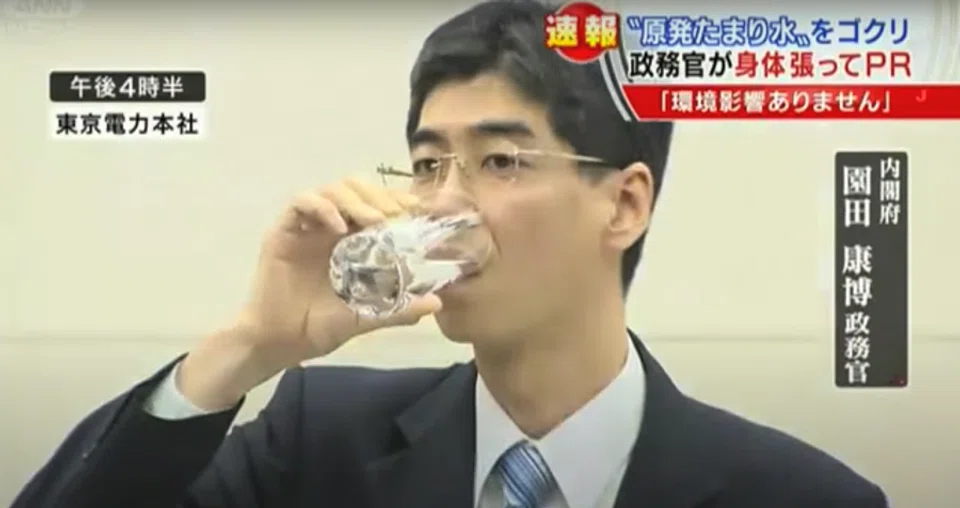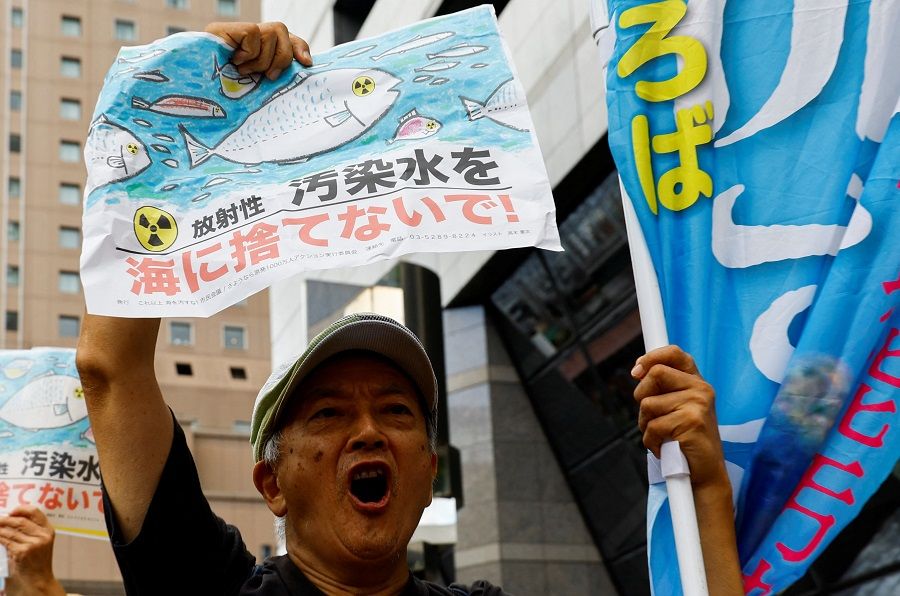Chinese academic: Can we die from drinking Fukushima treated wastewater?

On 24 August, Japan began releasing treated nuclear wastewater into the ocean, raising concerns in neighbouring countries. People are also reminded of former Japanese politician Yasuhiro Sonoda, who in October 2011 publicly drank half a cup of nuclear-contaminated water that he claimed had been treated.
Now, some Chinese we-media accounts are asserting that Sonoda had passed away in 2020 due to multiple myeloma (a blood disease) that caused his whole body to rot.
A cup of treated radioactive water
Based on common sense, the news is very likely just a rumour. And while there's little online information about Sonoda's current whereabouts, one cannot simply conclude that he has developed health problems or passed away from multiple myeloma.
Most importantly, the dose of a substance determines its toxicity. Thus, even if Sonoda did drink treated nuclear-contaminated water, it is impossible to tell whether the amount of radiation was high enough to cause disease or death.
On the flip side, there is no evidence to prove that treated nuclear wastewater is safe either. After drinking treated nuclear-contaminated water collected from the bottom of reactors No. 5 and 6, Sonoda said at a press conference that he only drank it because he was challenged to, and there was no assurance that it was absolutely safe.

There is currently insufficient scientific proof to support any claims that exposure to radioactive materials from the Fukushima nuclear power plant has resulted in any fatalities. This is unlike the 1986 Chernobyl disaster in the Soviet Union, where there is a strong causal relationship between the large amounts of radiation exposure and the illnesses and fatalities that occurred as a result of the catastrophe.
It can only be surmised that Curie was exposed to radionuclides for 35 years, from when she started her research on radioactive elements in 1899, to her death in 1934.
The case of Marie Curie
Historically, Marie Curie is one person who could prove that exposure to radiation causes blood diseases. On 8 November 2020 the Nobel Prize posted on Facebook: "Marie Curie died of aplastic anaemia on 4 July 1934, a result of years of exposure to radiation through her work. Even today her laboratory notebook from 1899-1902, is radioactive and will be for 1,500 years."
The precise amount of radiation Curie was exposed to, which caused her to acquire the deadly blood disorder aplastic anaemia, remains unknown. She did not have the proper protection during her research, as she was unaware that radionuclides are extremely lethal to the human body.
It can only be surmised that Curie was exposed to radionuclides for 35 years, from when she started her research on radioactive elements in 1899, to her death in 1934.

In 1903, Marie Curie, her husband Pierre Curie and Henri Becquerel were awarded the Nobel Prize in Physics for their research on radiation. Marie Curie later received the Nobel Prize in Chemistry in 1911 for the discovery of the elements radium and polonium, becoming the first person to receive two Nobel Prizes.
Aside from the discovery of the two elements, Curie's achievements include pioneering the science of radioactivity and inventing the technique for isolating radioactive isotopes. Radium was used for the first time in cancer treatment as a result of her contributions.
It has been analysed that Curie might have mostly been exposed to radium over a longer period of time. While the extremely rare polonium (atomic number 84) is highly toxic, Curie's exposure to it is negligible as it only has a half-life of 138 days. However, besides radium (atomic number 88) being a highly radioactive element, radium-226 of the radium isotopes is also the most stable with a half-life of 1,600 years. Hence, the Nobel Prize said that Curie's laboratory notebook would still be radioactive for another 1,500 years.
Dose-response relationship
There is no way to determine or study how much radiation Curie was exposed to. However, judging from the recommendations of the International Commission on Radiological Protection (ICRP) and the World Health Organization (WHO) on radiation safety levels, we live in a world filled with radiation and people should not be alarmed for no cause.
The ICRP and WHO set the radiation safety levels at 1 millisievert (mSv) per year, or 0.1 microsieverts (µSv) per hour (where 1 sievert equals 1,000 mSv, and 1 mSv equals 1,000 µSv). Occupational exposure limits for individuals subjected to radiation, such as hospital radiologists and nuclear power plant workers, are set at 20 mSv per year.
These limits apply to ionising or artificial radiation, not background radiation. Background radiation includes naturally occurring sources of radiation such as uranium deposits, granite layers and radiation emitted from food, while artificial radiation comes from human activities, including X-rays, CT scans, smoking and consuming nuclear wastewater.
Based on these dose-response relationships, it can be inferred that Curie was exposed to at least 100 to 500 mSv of radiation over many years, leading to the development of aplastic anaemia.

Studies have shown that short-term radiation doses below 100 mSv are not harmful to the human body. Between 100 and 500 mSv, there may be no immediate symptoms, but a decrease in white blood cell count can occur. Radiation doses of 1,000 to 2,000 mSv can lead to mild radiation sickness, including fatigue, vomiting, loss of appetite, temporary hair loss and reduced red blood cells.
Radiation doses of 2,000 to 4,000 mSv could damage bone marrow and bone density, leading to a severe decrease in red and white blood cells, as well as symptoms such as internal bleeding and vomiting. At doses above 4,000 mSv, there is a 50% mortality rate in the absence of medical intervention. Doses exceeding 6,000 mSv can potentially be fatal.
Based on these dose-response relationships, it can be inferred that Curie was exposed to at least 100 to 500 mSv of radiation over many years, leading to the development of aplastic anaemia.
The banana equivalent dose theory
The banana equivalent dose theory is an easy-to-understand concept that is now commonly used by nuclear radiation experts to measure radiation doses and their effects on humans.
A single banana contains approximately 0.0117% of radioactive potassium-40, equivalent to a radiation dose of 0.1 µSv, in line with the above-mentioned per hour safety level. To exceed the annual safety limit for artificial radiation, one would need to consume 10,000 bananas in a year, assuming that potassium as an element accumulates in the body over time. The risk of cancer will significantly increase only if it exceeds this level.
If a person were to consume 4 litres of water daily and exclusively drink Fukushima's treated nuclear wastewater, they would only be exposed to a radiation dose of 64 µSv, equivalent to 640 bananas.

Therefore, even if the treated nuclear wastewater consumed by Sonoda contained some radiation, it would not be enough to cause cancer or death. According to data monitored by the International Atomic Energy Agency (IAEA) when the nuclear wastewater was discharged on 24 August, the initial diluted radiation dose from the wastewater was approximately 16 µSv per litre, equivalent to the radiation from 160 bananas.
If a person were to consume 4 litres of water daily and exclusively drink Fukushima's treated nuclear wastewater, they would only be exposed to a radiation dose of 64 µSv, equivalent to 640 bananas. It is unlikely that anyone would exclusively drink Fukushima's treated nuclear wastewater or eat 640 bananas a day. Furthermore, the wastewater would be diluted by seawater, which would not be consumed directly.
Of course, there will have to be continuous monitoring following the treated nuclear wastewater discharge. The IAEA has already stated that it will conduct on-site monitoring and continue safety reviews throughout the discharge process, to fulfil IAEA director-general Rafael Gross's commitment that the agency will be involved before, during and after the water discharges.
This article was first published in Lianhe Zaobao as "喝核污水与癌症、死亡的关系".
Related: [Big Read] Doubts over Fukushima wastewater release hard to overcome | Japanese academic: China's strong views about Fukushima water will affect Japan-China relations | Japanese academic: A hard look at the true impact of Fukushima Daiichi water release | Frostier Japan-China ties with Fukushima treated wastewater discharge | Fukushima wastewater: Why China is protesting while the US gives the nod
